The Lenschow Lens
Geometry and solar radiation in action
Nov 7, 2011 - by Staff
Nov 7, 2011 - by Staff
Margaret LeMone | 8 November 2011 • As Don Lenschow walked on the sidewalk near the recently refurbished Anthes Building on 13 October, he noticed a patch of very warm air. Don, a colleague of mine in NCAR’s Mesoscale and Microscale Meteorology Division (MMM), was on his way to work around 9:25 a.m. MDT when the warm air caught his attention. Puzzled, he stopped to assess the situation. Warm air from the nearby sewer grate? None. Warm air mixing down? It was calm.
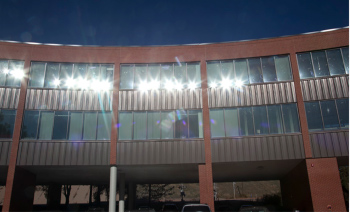
Photo 1. A row of solar reflections extends across the east-facing third-floor windows of the curved Anthes Building at 10:19 a.m. MDT on the morning of 14 October 2011. (©UCAR. Photos by Carlye Calvin.)
Then he noticed the brightness: the windows on the southeast side of the building were reflecting brightly (see Photo 1). He had hit the focal point of a lot of reflected sunlight.
After Don told me about his observation, we called Steve Oncley (NCAR Earth Observing Laboratory), who brought us a sling psychrometer, an instrument that measures both temperature and moisture when spun through the air on a rope (see Photo 2). Don and I then went over to the Anthes Building, where we took measurements of the temperature both inside and outside of the hot spot between 9:35 and 10:05 a.m., getting a difference on the order of about 10°C (18°F). In the hottest area, Don’s black shoes got so hot that he had to jerk his finger away when he felt them.
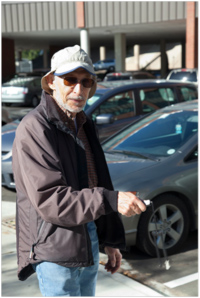
Photo 2. Don Lenschow assesses the hot spot with a sling psychrometer.
After talking about Don’s and my morning observations at lunch, Steve, Jielun Sun (also MMM), and I decided to go back over and take measurements the next day, October 14, except this time with two tools to measure infrared (IR) energy—an IR sensor and an IR camera—in addition to the psychrometer. We started at about 9:20 a.m. to target the time when Don experienced the hot patch. Sure enough, it was there again.
While I measured the IR temperature, UCAR photographer Carlye Calvin took a photograph that confirmed that solar radiation was being concentrated toward the hot spot. More than a dozen windows each showed a bright reflection of the Sun (see Photo 1). Since the reflections were all visible from the hot spot, we knew that at least some of the reflected sunlight was converging on us.
As I was spinning the psychrometer through the air in the hot spot, my pants (gray corduroy) grew hot; indeed, they started to smell like cloth under a hot iron.
At 9:34 a.m., the air temperature from the sling psychrometer was 20°C (68°F). Using a radiometer, Jielun measured a sidewalk temperature of 28°C (82.4°F).
Just outside the hot spot, about 5 meters (16 feet) to the north, Jielun found a sidewalk temperature of 12°C (54°F). Clearly the temperature of the ground surface—and our skin and clothes—was higher than the air temperature.
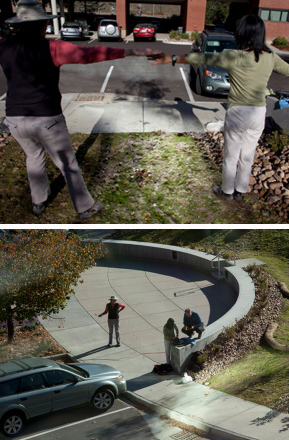
Photo 3 (top). With the Sun at their backs, Peggy LeMone (left) and Jielun Sun demonstrate how reflected sunlight from the Anthes Building erases parts of their shadows and casts a visible bright spot on the sidewalk.
Photo 4 (bottom). As the investigation continued, the bright spot gradually shifted, with the hottest observed ground temperatures moving to the brightly lit patch of gravel just above the sidewalk.
To get a subjective sense of how bright the reflections were, we experimented with our shadows. When Jielun and I stood side by side with our arms outstretched and our backs to the Sun (see Photo 3), the reflection from the windows was concentrated in such a way that there was a zone about a meter wide in which we cast no shadows. In the picture, the shadow of the tree behind us is also largely obliterated by the reflected light.
When Steve pointed an IR camera at the hot spot, he obtained variations in radiation temperature from 32°C (90°F) at the hot spot to 12°C (54°F) outside it. The difference between this hot-spot temperature and that taken by Jielun is not surprising: the radiometer she was using had not been calibrated. So Steve’s readings were more accurate.
After taking the shadow picture, Carlye went upstairs to photograph us at work—but, more importantly, she located the bright spot clearly (lower center of Photo 3).
By 9:47 a.m., the focal point had moved, become more diffuse, and involved fewer windows. The air temperature had risen to 17°C (63°F). Still, Jielun was able to find large variations in radiometric surface temperature on the ground, with the highest temperatures from the patch of gravel brightly illuminated in Photo 4.
What was happening? The Sun was at just the right angle for the windows in the building to act like a parabolic reflector.
On the right-hand side of Figure 1 below, a red parabola is superimposed on a schematic of the Anthes Building (the blue arc); all the points on the parabola reach a focal point (F in the figure). Parabolic reflectors are thus used to focus light, other electromagnetic waves, or sound. In this case, since the building extends upward, the focus is a vertical column whose base is marked by the bright spot on the ground in the photograph. The breadth of the column is due not only to the building being circular rather than parabolic, but also related to the windows being flat rather than curved.
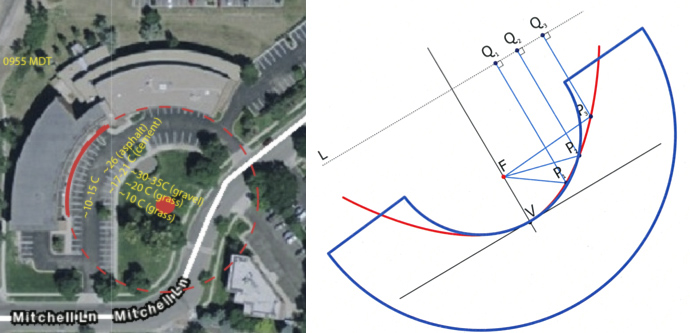
Figure 1. The nearly parabolic shape of the Anthes Building (left image, with observations added in yellow) leads to the observed hot spot (red dot in photo). This occurs as incoming solar rays (Q1 and Q2 in right image) reflect off windows and converge at point F. Ray Q3 hits the edge of the building rather than the inside arc of a true parabola (red), so it is not reflected toward F. (Base image at left courtesy Mapquest; base image at right courtesy Wikimedia Commons; both images modified to illustrate this article.)
Based on this idea, some concentrated reflection could be expected whenever the Sun’s rays fall inside the radius of the semicircle of windows in the Anthes Building. This effect may be slightly stronger now due to higher-efficiency windows installed this year as part of the building remodel. These help keep the interior cool by insulating more effectively and by reflecting a greater amount of sunlight. Since the Sun’s location in the sky is always changing throughout the day and the year, the hot spot is never in any one location for very long.
The same principle of parabolic reflection is now being used in a powerful and fast-growing type of solar energy production: concentrating solar power (CSS). By gradually shifting the location of large, strong reflectors, a powerful hot spot can be locked in place for a long time. So instead of warming our clothes or bodies for a brief moment, the hot spots in CSS are used to continuously heat fluid that runs through tubes and goes on to boil water and power a steam-driven generator.
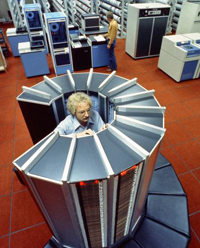
Photo 5. The NCAR Cray 1-A computer at NCAR in 1978, not long after its installation.
The circular shape of the Anthes Building has an interesting connection to NCAR’s past. Cray Laboratories was founded in 1979, a couple of years after NCAR took delivery of the first production-model Cray computer (the CRAY-1A, now a stop on public tours of NCAR’s Mesa Lab). About half of the current Anthes Building was built in 1980 to house Cray Labs. The shape of the building symbolized the curved shape of the Cray computers. The rest of the building, added in 2000, extended the curve, although by this point the structure had no connection to Cray.
Although it was a computer designed by Seymour Cray and company that led to the building’s circular shape, it was NCAR’s Don Lenschow who discovered the atmospheric implications. Don’s colleague Jimy Dudhia has suggested that we name the phenomenon the “Lenschow Lens.”
P.S.: Don also found a hot spot in the early afternoon. It would be fun to take a time-lapse photo of the hot spot as it travels across the front of the building!
>>>
Margaret "Peggy" LeMone spends much of her free time exploring ways to investigate the world of weather as a citizen scientist. An NCAR senior scientist emerita, she served as the 2010 president of the American Meteorological Society.